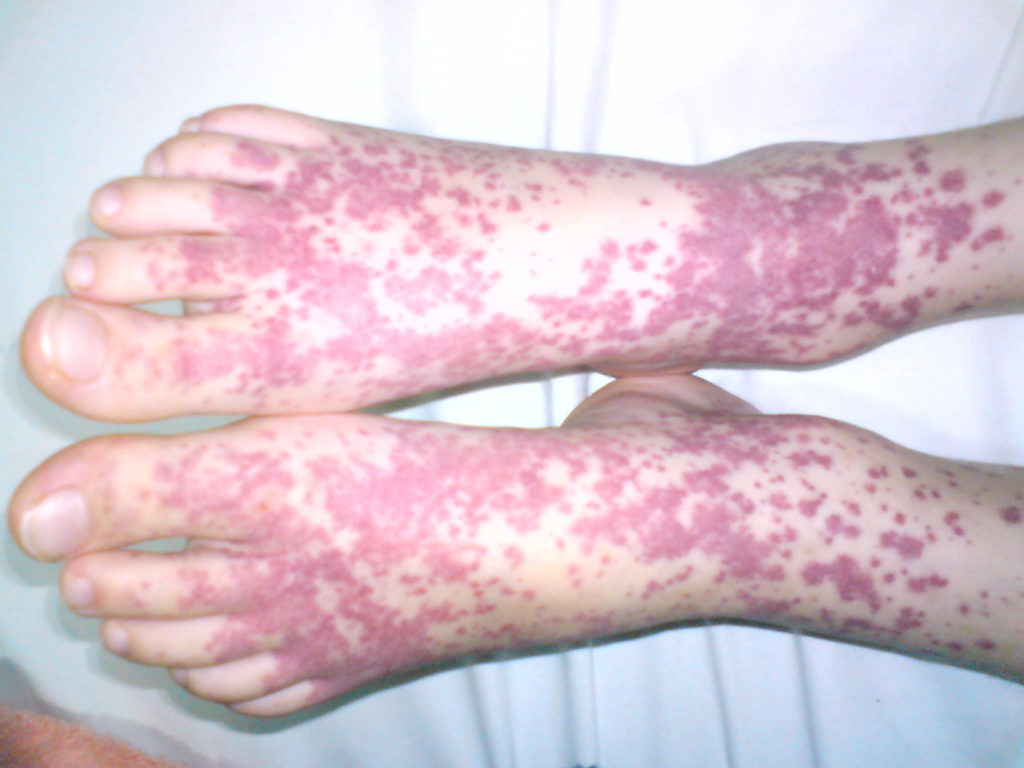Background
- Henoch-Schoenlein purpura (HSP) is an IgA-mediated small-vessel vasculitis caused by deposition of immune complexes within vessel walls
- >75% of patients with HSP are less than 10 years old, with a peak between ages 4 and 6 years
- White and Asian males are more commonly affected
- The etiology is often unknown; however, many cases are preceded by viral or bacterial upper respiratory infections
Clinical Manifestations
- Diagnosis is made based on rash and at least one of the following: (1) abdominal pain, (2) joint involvement, (3) renal involvement, or (4) histological features
- The first three will be discussed below; histological changes are beyond the scope of this discussion
- HSP is characterized by a symmetrically distributed palpable rash on dependent areas, particularly the buttocks and legs
- In infants the rash may appear in upper extremities, trunk, or face due to the dependent nature
- The rash is mostly purpuric, but may also be petechial or ecchymotic
- Non-pitting edema is common in younger patients
- The majority of patients may have GI involvement, including colicky pain, bowel edema, and bleeding
- Patients may develop intussusception as a result of bowel edema (see separate post)
- Most patients have migratory arthritis or arthralgias, usually without erythema or effusion
- Renal involvement is seen in up to half of cases, and ranges from microscopic hematuria and mild proteinuria to end-stage kidney disease caused by crescentic glomerulonephritis
- Vasculitis may affect the lungs (alveolar hemorrhage or interstitial disease, more common in adults), scrotum (swelling), and CNS system (encephalopathy or seizures)
- Labs generally show a normal CBC and BMP unless there is significant renal impairment; microscopic hematuria and/or proteinuria are common
- Differential diagnosis includes ITP, drug reaction, Rocky Mountain spotted fever, gonococcemia, and other vasculitides

Palpable Purpura
Management
- NSAIDs are the mainstay of treatment, as care is mostly supportive; they should be avoided if there is renal impairment
- Symptoms generally resolve in 4-6 weeks
- Prednisone may be used for severe joint and abdominal pain but does not prevent kidney involvement
- Immunosuppressants may be required for severe disease
Disposition
- Most patients can be discharged home with supportive care
- Indications for admission include renal failure and GI complications, including significant bleeding and intussusception
References
Guo D and Lam J. Henoch-Schonlein purpura. CMAJ October 18, 2016, 188 (15) E393; DOI: https://doi.org/10.1503/cmaj.151072
Reid-Adam J. Henoch-Schonlein Purpura. Pediatrics in Review October 2014, 35 (10) 447-449; DOI: https://doi.org/10.1542/pir.35-10-447
Trnka P. Henoch-Schonlein purpura in children. Journal of Paediatrics and Child Health October 2013, 45 (12) 995-1003. DOI: https://doi.org/10.1111/jpc.12403
